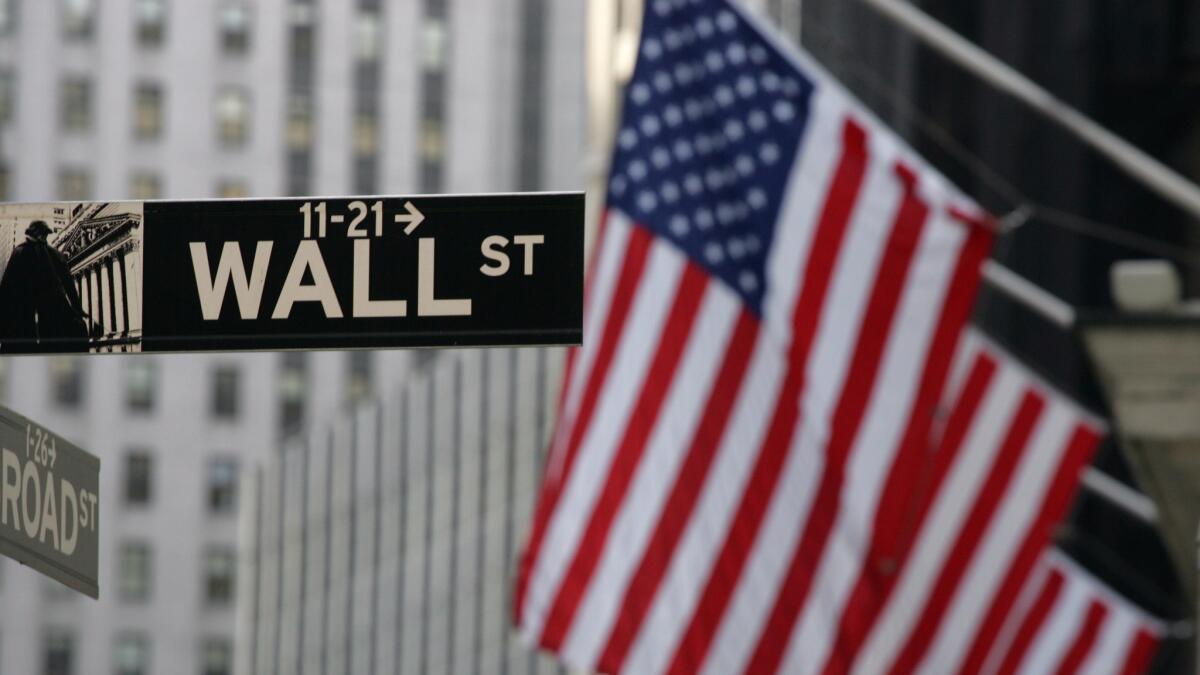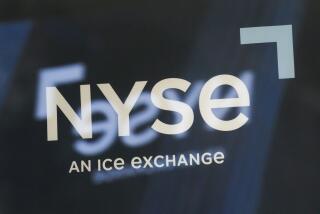Stock rally fizzles, and oil prices dive

- Share via
A big rally on Wall Street faded out Tuesday, the latest twist for a market dominated by sharp swings amid the coronavirus outbreak.
The benchmark Standard & Poor’s 500 index ended down 0.2%, erasing a surge of 3.5% from earlier in the day. The market’s gains faded as the price of U.S. crude oil abruptly flipped from a gain to a steep loss of more than 9%.
That dampened what had been an ebullient day for markets worldwide. European and Asian markets rallied earlier, following up on Monday’s 7% surge for the S&P 500 on encouraging signs that the coronavirus pandemic may be close to leveling off in some of the world’s hardest-hit areas.
Even though economists say a punishing recession is inevitable, some investors have begun to look ahead to when economies will reopen from their coronavirus-induced shutdown. A peak in new infections would offer some clarity about how long the recession may last and how deep it may be.
Investors could then, finally, envision the other side of the economic shutdown, after authorities forced businesses to halt in hopes of slowing the spread of the virus. In the meantime, governments around the world are talking about pumping trillions of dollars more of aid into the economy.
Many professional investors say they’ve been wary of stocks’ recent upsurge and expect more volatility ahead. The S&P 500 index has rallied nearly 19% since hitting a low March 23, though it’s still down 21.5% from the record high it reached in February.
“We shouldn’t over-extrapolate temporary trends,” said Patrick Schaffer, global investment specialist at J.P. Morgan Private Bank.
Such concerns were borne out in Tuesday’s trading, when the S&P 500 swung up, down, up, down and back up again through the day.
“We are still in what you would call the relief rally off of the prior low,” said Sam Stovall, chief investment strategist at CFRA. He noted that this kind of a rally is common within deep bear markets, Wall Street-speak for when stocks decline 20% or more from a peak.
“There’s no guarantee that the worst is behind us, yet traders believe that at least there is some short-term money to be made,” Stovall said.
The S&P 500 index fell 4.27 points Tuesday to 2,659.41. The Dow Jones industrial average slipped 26.13 points, or 0.1%, to 22,653.86; earlier in the day, it was up as much as 937 points. The Nasdaq composite fell 25.98 points, or 0.3%, to 7,887.26.
Oil prices have been even more volatile than the stock market in recent weeks as demand for energy has dried up amid a global economy weakened by the coronavirus outbreak. Russia and Saudi Arabia have also been locked in a price war, refusing to cut production sharply even as the world is awash in excess oil.
President Trump said last week that he hoped and expected the two sides could agree on production cutbacks, which helped prices spurt higher temporarily. But investors still aren’t convinced about a deal, and on Tuesday benchmark U.S. crude oil fell $2.45, or 9.4%, to settle at $23.63 a barrel. Brent crude, the international standard, fell $1.18 to $31.87 per barrel.
The decline in oil prices is another reminder of how many people are no longer driving to work, flying to meetings or heading to the store amid the economic shutdown. And the hangover could last a while.
“It’s very hard today to envision baseball stadiums in June filled with people drinking beer and watching games,” said J.P. Morgan Private Bank’s Schaffer. “People today don’t anticipate that the economy is going to turn back on like a light switch, but rather that it will be a gradual reopening of certain parts of the economy.”
Experts say more COVID-19 deaths are on the way. The disease caused by the coronavirus has already claimed at least 81,000 lives around the world. The U.S. has more than 386,000 confirmed cases, according to a tally by Johns Hopkins University.
More economic misery is also on the horizon. Economists expect a report Thursday to show that 5 million Americans applied for unemployment benefits last week as layoffs sweep the country. That would bring the total to nearly 15 million over the last three weeks. Analysts also expect big companies in upcoming weeks to report their worst quarter of profit declines in more than a decade.
But investors have grabbed on to some glimmers of optimism. China, the first country to lock down wide swaths of its economy to slow the spread of the virus, reported no new deaths across 24 hours. Many experts are skeptical of China’s virus figures, but investors also see signals that the number of daily infections and deaths may be close to peaking or plateauing in Spain, Italy and New York.
Central banks and governments are promising massive amounts of aid to prop up the economy.
Japan’s government on Tuesday formally announced a $1-trillion package for the world’s third-largest economy.
In the U.S., the White House is seeking an additional $250 billion for a program to help small businesses, which was part of the $2.2-trillion rescue package Congress approved last month.
In Europe, Germany’s DAX jumped 2.8%, and France’s CAC 40 rose 2.1%. The FTSE 100 in London added 2.2%. In Asia, Japan’s Nikkei 225 rose 2%, South Korea’s Kospi gained 1.8% and the Hang Seng in Hong Kong was up 2.1%.
In a signal that investors are feeling less pessimistic about the economy and inflation, they pushed the yield of the 10-year Treasury up to 0.72% from 0.67%.
More to Read
Inside the business of entertainment
The Wide Shot brings you news, analysis and insights on everything from streaming wars to production — and what it all means for the future.
You may occasionally receive promotional content from the Los Angeles Times.










